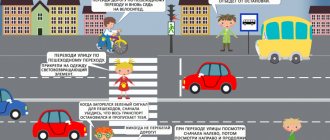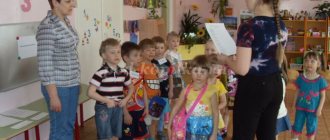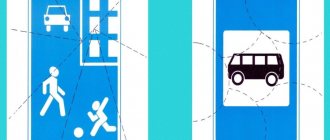A collection of didactic games on the basics of safety for preschool children
Svetlana Gevorkyan
A collection of didactic games on the basics of safety for preschool children
Didactic game “What is useful and what is not?”
Purpose of the game: To form in children ideas about healthy foods, the benefits of vegetables and fruits, and proper nutrition. Help children realize that often advertised products are not the healthiest. Teach children to be conscious about their diet. Develop children's .
Equipment: cards with images of healthy and unhealthy foods.
Progress of the game: the child is given a playing field, on the field the child lays out only those cards that depict products useful for the human body. Cards that depict junk food are put aside.
Didactic game “Dangerous - not dangerous.”
Purpose of the game: 1. To teach children to distinguish life-threatening situations that threaten their health and the health of others from non-hazardous ones;
2. Be able to foresee and prevent the results of possible developments of the situation;
3. Reinforce and follow the rules of safe behavior in various situations;
4. Develop a protective self-awareness.
5. Foster a sense of mutual assistance;
Game task:
Determine the degree of threat of the proposed situation to life and health.
Determine which of the situations described poses a health threat.
Raise the required card depending on the degree of danger.
Correctly arrange didactic pictures .
Rules of the game: children should not interfere with each other’s listening and answering; if necessary, they can supplement the answers of their comrades.
Demonstration material: a set of didactic pictures depicting situations that are dangerous and non-hazardous to life and health, cards with green and red colors.
Progress of the game: 1. After carefully listening to the teacher’s story, the children raise a red card if there is danger, and a green card if there is none.
2. The guys carefully examine the didactic pictures that the teacher shows, then raise a red card if there is a threat to life and health; green - if there is no danger. In each case, they explain their decision.
3. The teacher invites the children to work independently with didactic pictures ; Pictures depicting life-threatening situations should be placed under the red card, and pictures depicting non-hazardous situations should be placed under the green card.
The children explain their choice (help from the teacher if the children find it difficult to answer)
.
Didactic game “What is good and what is bad”
Purpose of the game: to clarify children's about environmentally correct behavior.
Material: story pictures.
Progress of the game: invite children to identify in the pictures and choose those in which the child behaves well, takes care of his body (in rainy weather, go outside with an umbrella, play sports, eat healthy foods, etc.)
Didactic game “Choose edible mushrooms and berries”
Purpose of the game: to consolidate knowledge about edible and poisonous plants, the ability to distinguish them from each other.
Material: baskets, dummies or cards depicting edible and poisonous mushrooms and berries, chips.
Progress of the game: offer to collect edible mushrooms and berries in baskets, and “inedible”
leave in the forest. For each correctly chosen plant, a chip. The player with the most chips wins.
Didactic game “Let’s pack a backpack for the road”
Purpose of the game: to expand children's ideas about objects that can be useful in emergency situations in nature, about the correct actions in specific situations, to develop intelligence.
Material:
— pictures depicting items that you can take on a camping trip.
Progress of the game: each child chooses a card with an item that he wants to take with him and explains for what purpose this item can help in a difficult situation.
Didactic game “I’ll be careful in nature”
Purpose of the game: to consolidate children's about dangerous situations in nature, teach the rules of safe behavior , develop memory, and cultivate a sympathetic attitude towards the victim.
Material: pictures depicting children in dangerous situations in nature.
How to play: The pictures are laid out face down on the table. The child chooses a picture, examines it and talks about what is depicted in it and why this happened to the child.
Didactic game “Nature and Man”
Purpose of the game: To consolidate and systematize children’s knowledge about what is created by man and what nature gives to man.
Game rules. You can answer only after you have caught the ball. The person who names the object throws the ball to another participant.
Game actions. Throwing and catching the ball. Those who cannot remember miss their turn, hit the ball on the floor, catch it, and then throw it to the driver.
Progress of the game: The teacher conducts a conversation with the children, during which he clarifies their knowledge that the objects around us are either made by human hands, or exist in nature, and people use them; for example, forests, coal, and gas exist in nature, but houses, factories, and transport are created by humans.
“What is made by man?”
- the teacher asks and hands one of the players an object
(or throws a ball)
.
After several answers from the children, he asks a new question: “What is created by nature?”
During the game, the teacher has a short conversation with the children about how people use nature to make people’s lives better, and at the same time take care of nature: protect forests from fires, clean ponds, lakes and rivers, protect animals and birds .
Didactic game “Tops and Roots”
Purpose of the game: To train children in classifying vegetables (based on the principle: what is edible - the root or the fruit on the stem)
.
Game rules: You can answer only in two words: tops and roots. Whoever makes a mistake pays forfeit.
Game actions. Playing forfeits.
Progress of the game: The teacher clarifies with the children what they will call tops and what roots: “The edible root of a vegetable is called tops, and the edible fruit on the stem is called tops.” The teacher names a vegetable, and the children quickly answer what is edible in it: the tops or roots. The teacher warns the children to be attentive, since some vegetables contain both of them. The teacher calls: “Carrots!”
Children answer:
“Roots”
,
“Tomato!”
-
“Tops”
.
"Onion!"
-
“Tops and Roots”
. The one who makes a mistake pays a forfeit, which is redeemed at the end of the game.
The teacher may offer another option; he says "tops"
, and children remember vegetables whose tops are edible. This game is good to play after a conversation about vegetables and gardening.
Outdoor safety games for preschoolers
Outdoor safety games for preschoolers are mostly held in the form of relay races. Children are divided into two teams. In such games, instead of a regular signal, you can use a recording of a fire siren.
Game "Fire"
To play, you will need children's firefighter costumes: helmet, belt, gloves, overalls.
At the signal, players start from the starting line and run to the chairs on which the firefighter suits are lying. The guys must get dressed, return to their team, undress and give the suit to the next participant.
The winner is the team that gets ready for the fire
.
Game "Fire fees "
To play you will need a table and various items, including “borrowed” ones.
from the fire department: cord, gas mask, helmet.
At the signal, players run to the table on which items are laid out, select one item necessary for the firefighter’s work, and return to the team.
The winner is the team that completes the task faster and, most importantly, more correctly than others.
Game "Brave Firemen"
To play the game you will need to prepare an obstacle course. At the end of it there is a model of the house in which they “live”
toys.
At the signal, the children begin the relay race: they run through an obstacle course, “rescue”
one toy from home and return to their team. The goal is to save all the inhabitants of the toy house.
The team that provides assistance to the victims the fastest wins.
Game "Put out the fire"
To play you will need a sandbox or a basin of sand.
At a signal, children scoop up sand with a small scoop and run towards the “fire”
- a piece of paper with a picture of a flame. You need to run carefully so as not to spill the sand.
The winner is the team that brings the most sand and, accordingly, puts out the flames faster.
Game "After the Fire"
Two players from each team participate. To play you will need a large reel with a cord attached.
At the leader’s command, the participants begin to wind the cord onto a reel. Those who complete the task first win.
Game "Corridor"
There are tunnels in front of each team.
At the signal, the participants crawl through the tunnel and run back to their team.
Game "Two boots - a pair"
Teams are divided into pairs. Pairs tie (one player's left leg to the other player's right leg)
.
You need to, holding hands, jump to a hoop simulating a house on fire and “save”
the toy from there.
The team that saves all the victims faster than others wins.
Game "01
For this game you need to prepare leaves and markers.
At the signal, the participants of each team begin to run to the other side of the hall. There is a piece of paper on the chair on which you need to write with a marker “01, that is, call the fire department.
The game continues until all children write “01.
Game: Pass the Baton
The players line up in a circle. The leader passes the traffic controller's baton to the player who stands to his left, who also passes the traffic controller's baton to the player who stands to his left, and he passes it to the next one. A prerequisite is to accept the rod with your right hand, then pass it with your left. The program is accompanied by music; as soon as the music stops, the one who has the baton left must say a proverb on the topic of the road. If he does not remember or repeats a previously heard proverb, he is eliminated from the game. The one who knows more proverbs and sayings wins.
Game: Stop
(for middle group)
At one end of the hall (platform)
the starting line is drawn.
Playing children line up around her.
(teacher)
stands at the other end of the hall (platform) .
The driver raises a green flag and says:
- Walk quickly, watch, don’t yawn!
The players walk towards the driver, but at the same time make sure that the green flag is still raised. If the driver raises a red flag and says “Stop!”
, the players stop and freeze in place. If the yellow flag goes up, you can move but remain in place. When the green flag goes up again, the players move forward.
Anyone who does not stop in time or starts moving forward at the yellow signal of the flag returns to the starting line.
The winner is the one who completes the entire journey first without mistakes.
Game: Red, yellow, green
(for the younger group)
The game is aimed at attention and reaction development.
Children sit on a bench or on chairs. If the teacher raises the green flag, the children stomp their feet. If the yellow flag is raised, they clap their hands. If it’s red, they sit without moving or making a sound. The one who makes a mistake is out of the game.
Option: the one who makes no mistakes receives a token, and at the end of the game a sweet prize.




